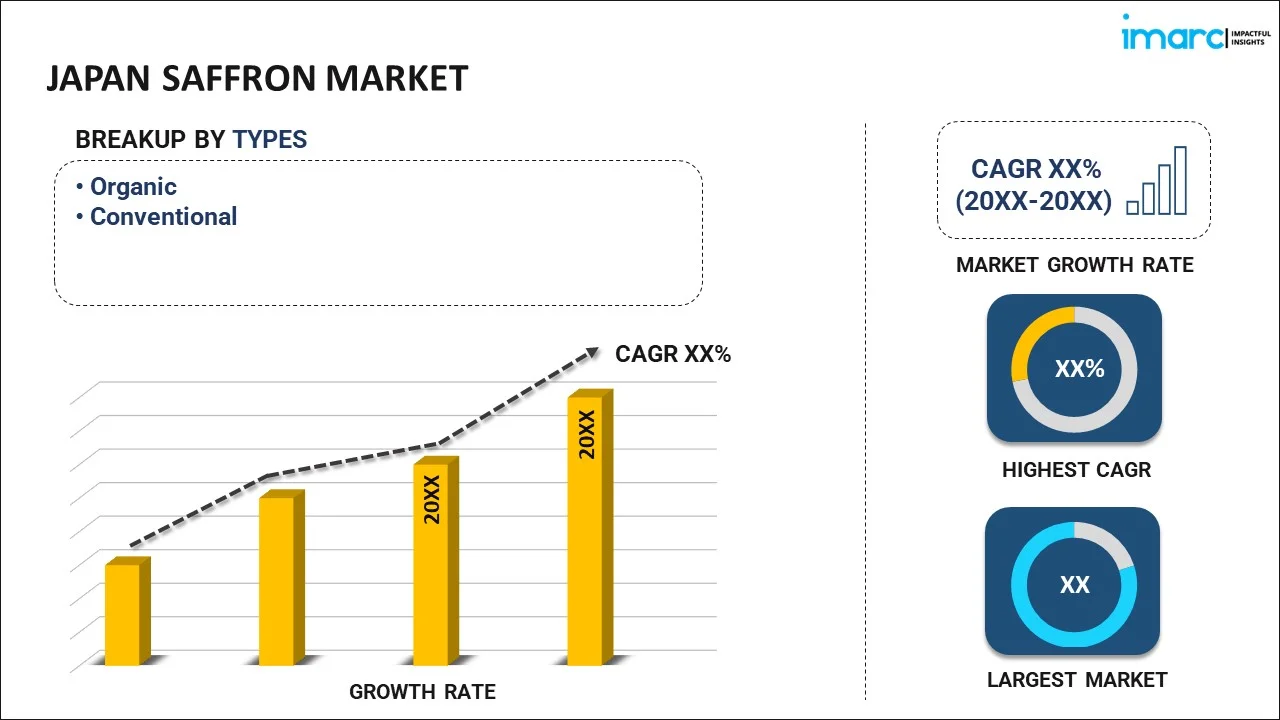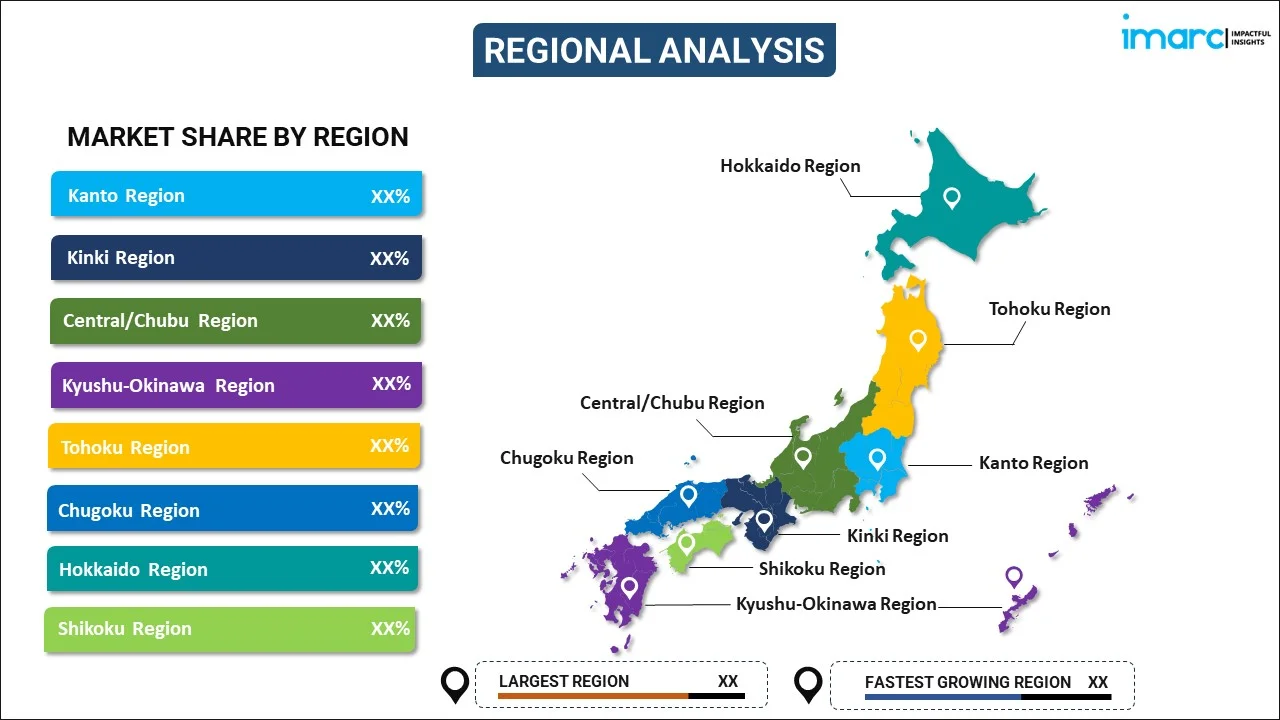
Japan Saffron Market Report by Type (Organic, Conventional), Form (Thread, Powder, Liquid), Application (Food, Pharmaceutical, Cosmetics, and Others), and Region 2025-2033
Market Overview:
The Japan saffron market size reached USD 2.5 Million in 2024. Looking forward, IMARC Group expects the market to reach USD 3.9 Million by 2033, exhibiting a growth rate (CAGR) of 4.8% during 2025-2033. The escalating consumer consciousness regarding health and wellness trends, the expanding influence of global culinary trends, the bolstering tea culture, and widespread product applications in the pharmaceutical and cosmetic industries represent some of the key factors driving the market.
|
Report Attribute
|
Key Statistics
|
|---|---|
|
Base Year
|
2024 |
|
Forecast Years
|
2025-2033
|
|
Historical Years
|
2019-2024
|
| Market Size in 2024 | USD 2.5 Million |
| Market Forecast in 2033 | USD 3.9 Million |
| Market Growth Rate (2025-2033) | 4.8% |
Saffron is a luxurious and highly prized spice renowned globally for its distinct flavor, color, and medicinal properties. It is obtained from the Crocus sativus flower, a perennial plant in the Iris family. Saffron contains several plant-derived compounds, such as crocin, picrocrocin, and safranal, which are believed to act as antioxidants. It helps improve mood, memory, and learning ability and may even have potential benefits in treating depressive symptoms. As a result, saffron is widely employed for its therapeutic properties and as a potent dye and perfume. It was also used in religious ceremonies. Besides this, saffron is cherished for its unique, earthy flavor and vibrant golden hue to dishes. It is a key ingredient in many traditional dishes worldwide, such as Spanish paella, Persian pilafs, Italian risotto alla Milanese, and Indian biryanis.
Japan Saffron Market Trends:
The escalating health-conscious among individuals, often attributed to the high life expectancy in Japan, represents one of the prime factors impelling the market growth. In line with this, the surging consumption of saffron, due to its rich antioxidant content and numerous health benefits such as improved mood, memory, and eye health, is creating a favorable outlook for market expansion. Moreover, the prevalent influence of global cuisines on Japan's food culture is aiding in market expansion. Besides this, Japan has a robust luxury market, and the high cost and exclusivity of saffron make it a desirable luxury commodity. In the context of gift-giving, a significant aspect of Japanese culture, saffron is often seen as a high-end choice, influencing the market growth. Additionally, the bolstering tea culture in the country further contributes to saffron’s market growth as consumers seek new flavors and health-infused variants. Furthermore, the wid’spread product utilization across the flourishing pharmaceutical industry, wherein saffron is used’In traditional medicines and potentially modern therapies, is contributing to the market's growth. Concurrent with this, the rising demand from the cosmetics industry due to saffro’'s potential antioxidant and anti-inflammatory properties is presenting remunerative growth opportunities for the market. Apart from this, the bolstering growth of the e-commerce sector and the convenience associated with online shopping have made it simpler to procure this exotic spice, thus fueling the market growth.
Japan Saffron Market Segmentation:
IMARC Group provides an analysis of the key trends in each segment of the Japan saffron market report, along with forecasts at the country level for 2025-2033. Our report has categorized the market based on type, form, and application.
Type Insights:

- Organic
- Conventional
The report has provided a detailed breakup and analysis of the market based on the type. This includes organic and conventional.
Form Insights:
- Thread
- Powder
- Liquid
A detailed breakup and analysis of the market based on the form has also been provided in the report. This includes thread, powder, and liquid.
Application Insights:
- Food
- Pharmaceutical
- Cosmetics
- Others
The report has provided a detailed breakup and analysis of the market based on the application. This includes food, pharmaceutical, cosmetics, and others.
Regional Insights:

- Kanto Region
- Kinki Region
- Central/Chubu Region
- Kyushu-Okinawa Region
- Tohoku Region
- Chugoku Region
- Hokkaido Region
- Shikoku Region
The report has also provided a comprehensive analysis of all the major regional markets, which include Kanto Region, Kinki Region, Central/Chubu Region, Kyushu-Okinawa Region, Tohoku Region, Chugoku Region, Hokkaido Region, and Shikoku Regions.
Competitive Landscape:
The report has also provided a comprehensive analysis of the competitive landscape in the market. Competitive analysis such as market structure, key player positioning, top winning strategies, competitive dashboard, and company evaluation quadrant has been covered in the report. Also, detailed profiles of all major companies have been provided.
Report Coverage:
| Report Features | Details |
|---|---|
| Base Year of the Analysis | 2024 |
| Historical Period | 2019-2024 |
| Forecast Period | 2025-2033 |
| Units | Million USD |
| Scope of the Report | Exploration of Historical and Forecast Trends, Industry Catalysts and Challenges, Segment-Wise Historical and Predictive Market Assessment:
|
| Types Covered | Organic, Conventional |
| Forms Covered | Thread, Powder, Liquid |
| Applications Covered | Food, Pharmaceutical, Cosmetics, Others |
| Regions Covered | Kanto Region, Kinki Region, Central/Chubu Region, Kyushu-Okinawa Region, Tohoku Region, Chugoku Region, Hokkaido Region, Shikoku Region |
| Customization Scope | 10% Free Customization |
| Post-Sale Analyst Support | 10-12 Weeks |
| Delivery Format | PDF and Excel through Email (We can also provide the editable version of the report in PPT/Word format on special request) |
Key Questions Answered in This Report:
- How has the Japan saffron market performed so far and how will it perform in the coming years?
- What has been the impact of COVID-19 on the Japan saffron market?
- What is the breakup of the Japan saffron market on the basis of type?
- What is the breakup of the Japan saffron market on the basis of form?
- What is the breakup of the Japan saffron market on the basis of application?
- What are the various stages in the value chain of the Japan saffron market?
- What are the key driving factors and challenges in the Japan saffron market?
- What is the structure of the Japan saffron market and who are the key players?
- What is the degree of competition in the Japan saffron market?
Key Benefits for Stakeholders:
- IMARC’s report offers a comprehensive quantitative analysis of various market segments, historical and current market trends, market forecasts, and dynamics of the Japan saffron market from 2019-2033.
- The research study provides the latest information on the market drivers, challenges, and opportunities in the Japan saffron market.
- Porter's five forces analysis assist stakeholders in assessing the impact of new entrants, competitive rivalry, supplier power, buyer power, and the threat of substitution. It helps stakeholders to analyze the level of competition within the Japan saffron industry and its attractiveness.
- Competitive landscape allows stakeholders to understand their competitive environment and provides an insight into the current positions of key players in the market.
Need more help?
- Speak to our experienced analysts for insights on the current market scenarios.
- Include additional segments and countries to customize the report as per your requirement.
- Gain an unparalleled competitive advantage in your domain by understanding how to utilize the report and positively impacting your operations and revenue.
- For further assistance, please connect with our analysts.
 Request Customization
Request Customization
 Speak to an Analyst
Speak to an Analyst
 Request Brochure
Request Brochure
 Inquire Before Buying
Inquire Before Buying




.webp)




.webp)












